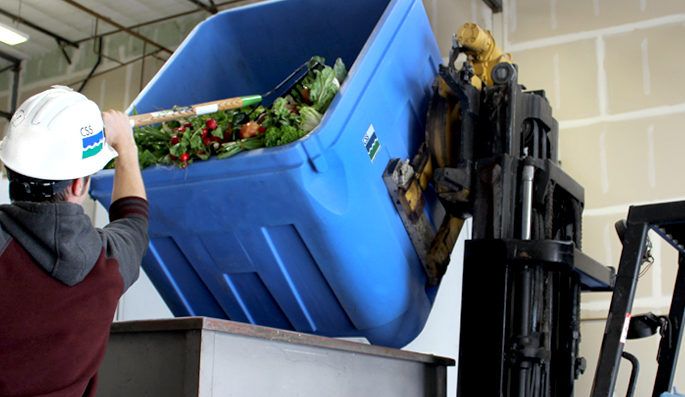California Safe Soil (CSS) technology is headed to the East Coast in a big way with the goal of ending supermarket fresh food waste in the United States in five years.
CSS uses a patented enzymatic digestion process to turn fresh food waste into fertilizer and animal feed. And one of its investors — board member Justin Kamine of KDC Agriculture, a subsidiary of Kamine Development — is licensing the tech to build a plant somewhere in the New York City tristate area. In addition to the Kamine family, Howard Buffet and former USDA Secretary Anne Veneman are on KDC Ag’s advisory board.
The $40 million East Coast plant will be roughly double the size of CSS’s West Sacramento facility, taking in 60,000 tons of fresh food waste per year generating 12 million gallons of fertilizer and 12 million pounds of animal feed. CSS’s current plant in West Sacramento will be able to process 30,000 tons of waste when the 80,000 sq.ft. facility is fully built out.
The process has four steps that mimic human digestion and lead to a stable a customizable result. First, the fruits, vegetables, baked goods and meat are ground to a sludge. Then enzymes are introduced to break down the fatty acids, amino acids and proteins. Next, the liquid is pasteurized using a heat and motion method, and finally a centrifuge is used to standardize the mixture into the fat, protein and simple sugar ratio needed to produce the company’s certified organic fertilizer product, called “Harvest to Harvest” (H2H), or any custom ratio that customers request.
Kamine says that the animal feed product, which is new for CSS, could compete with commodity crops in animal feed. “We can custom tailor the exact diet that an animal would want at each stage of their life in a 100% sustainable, circular economy, therefore eliminating the need for corn and soy to be fed to those animals and for them to be pumped with antibiotics.”
CSS has a longterm contract with SaveMart supermarkets in California, among others. Eighty percent of supermarket waste is culled produce, with the remainder made up mostly of meat and fish scraps. CSS provides insulated bins on wheels for the stores to fill and return to their distribution centers where the waste is then brought to the CSS facility within one day.
Dan Morash, CEO of CSS says his fee is lower than municipal collection rates for food waste and 10-year contracts allow him to offer the resultant fertilizer at a fixed price. Kamine intends to run with a similar model on the east coast and is currently lining up contracts with grocers.
Morash had to prove the safety of his process to regulators in California in a lab setting simulating the CSS process. E. coli, salmonella and listeria were all introduced into the food waste and put through the digestion process. According to Morash, each step of his process killed the pathogens, leading the California Department of Food and Agriculture to approve CSS to build a plant anywhere in the state. “CDFA has a lot of food safety concerns about other technologies like anaerobic digestion and composting because they don’t have that pathogen kill step that our process does,” says Morash, who adds that if his technology received regulatory approval in California, he expects no trouble elsewhere.
On a recent tour, we discovered that the plant itself has very little of the odor one might expect in a waste processing facility and blends into a typical Sacramento business park.
Morash and Kamine describe the CSS technology as city infrastructure, not unlike a utility — something the Kamine family has experience with. “For the past 30 years our family has been developing large scale infrastructure across the US,” says Kamine, whose family business has built out infrastructure for telecom, natural gas, and solar. Now Kamine’s goal is to reclaim all of the US supermarket fresh food waste in the next five years.
The need for food waste recovery and repurposing is well-trod territory, but few solutions other than simple awareness have surfaced. Forty percent of food produced in the US goes to waste or as Morash put it to the farmers at the Forbes AgTech Summit: “Everything you do every Monday and every Tuesday goes into the trash.”
Not only are CSS and KDC making a play to divert food waste from land fills and incinerators, they are also hoping that farmers will come around to the fact that soil health is a worthy investment. According to the United Nation Food and Agriculture Organization, the soil can only support 60 more years of harvests. “Our challenge is convincing farmers that soil health can provide good return on investment,” said Morash.
The focus in the near-term for CSS in California is building out a sales team to increase the market for their fertilizer product. “It just takes time for farmers to adopt new technology and there’s always a healthy level of skepticism that this is snake oil,” says Morash. Kamine will be building out the East Coast facility and holds a license for national development and commercialization of CSS’s process and products.
CSS has raised $17 million in total since founding including a $5.9 million round initiated on the AgFunder platform in 2015.
Kamine Development has also invested in New Jersey-based indoor farming company AeroFarms and sustainable packaging and tableware company Loliware, among others.




